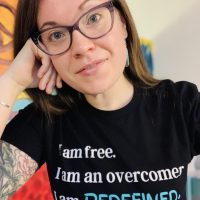I remember the season when I took long morning walks.
He was gone at work, and for a few hours, I pretended to be free.
My mind had space to dream about the future, and I gained power with each step. I gazed at the apartment buildings. I looked at the tiny houses with adorable gardens. I fantasized about living in one of them. I daydreamed of an escape from the narcissism. I breathed breaths of empowerment as I budgeted and planned in my mind during those walks.
Months later, I made my final escape from an unhealthy relationship, but as many survivors find, the familiar pattern of limiting beliefs, self-judgment, and powerlessness was still etched on my heart. Those old victim-feelings were all mingled together with the new I-am-woman-hear-me-roar battle cries that had surged me forward through the separation process and grief.
I was indeed a capable and competent woman, but my brain didn’t fully know it yet.
Our brains like patterns. They like repetition. They want what’s familiar, what’s comfortable.
But the thing is, familiar emotional patterns don’t always serve us well. The way we related to others in childhood, or the way we related to our abusive partners, will not work in our favor once we’re out of those environments.
For those of us who’ve experienced relational trauma, our brains have some catching up to do. In order to become the fullest version of ourselves, we have to break our default, subconscious patterns. Just as I began to do on those morning walks so many years ago, we have to teach our brains:
I am strong now. I can protect myself. I love myself. I know what I need. I have a new pattern for you.
So how do we recognize the unhelpful patterns, make a conscious choice to change them, and step boldly to the other side? And how do we keep on doing this, through endless phases of growth and healing?
Of all the important factors that have aided my recovery from narcissistic abuse (not the least of which are therapy, art, support groups, and friends), here are two unexpected discoveries I’ve made:
1. We need to stop reading about narcissism.
Imagine that you’re holding a playing card in front of your face—the queen of hearts. The queen is on one side, and a decorative pattern is on the other side. The queen is facing you right now. That means you can’t see the opposite side. You are completely focused on her and might even forget what the other side of the card looks like if you stay focused on her long enough.
If you choose to flip the card, however, the opposite is true; you can only see the design on the back of the card. The queen isn’t visible at all.
What’s my point here?
You’re the queen. As long as you choose to focus on yourself and your dreams, goals, and ambitions for this new, abuse-free life you’ve created, then it’s pretty impossible to keep focusing on the narcissist.
In contrast, if you’re continuing to focus on the narcissist, obsessing about the relationship, and all their manipulative tactics (the other side of the card), you can’t focus on yourself at all. You can’t even see yourself. You might even forget what you look like.
And yet, this is the mistake so many of us make when trying to heal from narcissistic abuse. We spend months, or even years, reading and learning about narcissism. We analyze. We overthink. We read some more.
In the beginning, this was helpful, right? I call it the “information gathering phase.” We all go through this. It’s what helps us feel sane because we’re reading so many things that align with our experience, and finally, we can yell from the rooftops, “I’m not the crazy one!”
It helps us make sense of our circumstances and gain much-needed insight and a feeling of control.
But, remember how our brains like patterns? We are so accustomed to the narcissist consuming our thinking, that this information-gathering phase not only feels helpful (at first), but also familiar. It’s comfortable. It’s just like home. We often fool ourselves into thinking we’re making progress in our healing, when we actually haven’t done a thing to move ourselves toward our dreams.
We’re too busy staring at the back of the card. We need to flip it and focus on ourselves. We need to put down the narcissistic abuse book and unfollow a few social media accounts. It’s time to live life looking forward, instead of looking back.
2. We need to do something that feels big.
Once the relationship was over and I’d started settling into a new life, my therapist issued me a challenge. She gently urged me to set up an artmaking space in my new apartment. My creativity was a trait held closely to my sense of identity, and I hadn’t tapped into it lately. My therapist was encouraging me to reconnect with that artist part of myself, now that I was living on my own terms.
She didn’t know it, but I’d already been thinking about this. And I wasn’t merely interested in clearing out a corner of the kitchen to make room for a canvas or two. I had a bigger idea in mind but no concrete plan to act on it. I’d felt hesitant because I wasn’t used to investing in myself. I was well-versed in showing up for others, but out of practice at caring for me in the ways that mattered most. I felt powerless to actually take action in my life toward anything that seemed big, out-of-the-box, or like it would bring me attention.
As survivors of narcissistic abuse, we tend to look to others for permission to act. Even when it comes to smaller decisions (for example, “Where do you want to go for lunch?”), we shrink back, defer to others, and don’t want to step on any toes. And if we do take a leap into that unknown territory of decisiveness and assertion, we often apologize and are riddled with anxiety (“Did I offend anyone?”).
But if we’re going to get where we want to be on this healing journey, we have to break this pattern as well. We have to step up and claim something big for ourselves, free of self-judgment or worries about others’ opinions. We need to teach our brains that it’s okay to take risks.
Right before I was scheduled to meet for therapy the following week, I stopped by a local art center that leased small studio spaces. I wanted a room all on my own, where I could let loose, feel free, get messy, and create without any rules. I had all the details worked out in my mind. Now it was just a matter of getting a quick tour of available spaces, choosing one, signing a lease, and submitting payment.
After months of overthinking, I finally gave myself permission to act. And that one action would give birth to an incredible amount of growth and change in my life. I honestly can’t imagine where I’d be if I had not taken the leap and made this choice that felt so big at the time.
The thing that felt risky. The thing that felt scary. The decision that some friends would have cautioned me not to make. That choice was a crucial turning point for the better.
It wasn’t selfish or foolish. It was necessary.
So when you’re feeling stuck in life and wonder if you’ll ever break free from the lasting effects of narcissistic abuse, remember:
Be the queen.
Take a risk.
We’ve got to choose ourselves first, no matter what others might think. Not everyone understands the hell we’ve been through. Trust your intuition and the voices of others who’ve been there.
All the power you need to heal is already inside you. One thousand times over.
~









Read 20 comments and reply